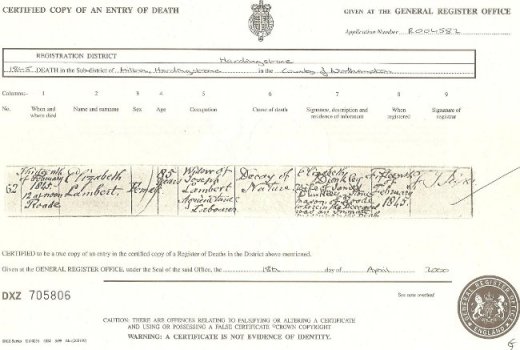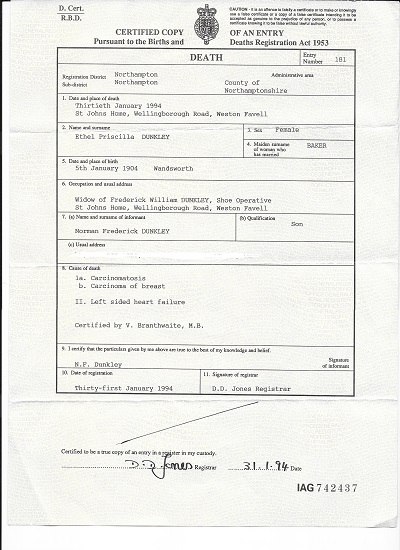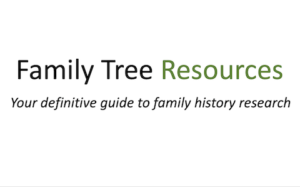A death certificate is important to family history research because after 1837 a burial was only allowed if a valid certificate was produced, which meant the civil authorities had been notified of the death. Until 1874, the registrar had to register a death, using information provided by the informant, but since 1874, responsibility for registering the death laid with the next of kin or closest relative of the deceased.
Although the GRO Index on microfiche does not include ages at death of people who died before 1866, the GRO has now re-indexed these entries in their online index, adding ages at death in most cases, although you do have to register to use this index.
Deaths were recorded where they took place, and this may not necessarily be where the person had lived. If a person died in hospital, for example, and this was in a different registration district to where the person usually resided, the death would be registered in that district.
A death certificate can help you to determine if you have discovered the correct death registration in the GRO Index, especially if your ancestor has a common name such as John Smith.
If you are unable to find a death registration for your ancestor, it may be because the name by which you knew them by may not be the name that appears on the certificate.
Details on a Death Certificate
Heading on a Certificate
The heading of the death certificate states the year the event took place in, the registration district, the sub-district if applicable, and the name of the county.
No.
This number signifies the entry number in the register.
Date and Place of Death
This column shows the deceased’s date and place of death. When looking at their place of death, please note that this is where they died, and may not necessarily be their home address.
Name and Surname of Deceased
The name and surname of the deceased is shown in this column, as stated by the informer of the death. If you are looking for a person such as Nora Alice, and cannot find their entry in the index, it is best to look for Alice Nora in case she changed her name.
it is also possible that if Nora Alice was known throughout her life as Alice that is the name on the certificate.
If you find that the death is registered as male or female, there is a high possibility that the deceased was a child and had not lived long enough to be named.
Since 1969, if a woman was married, her maiden name was also listed on the certificate.
Sex of Deceased
This column records whether the deceased was male or female.
Age at Death
Age at death is stated in this column. Their age is very useful because it could help you to find the correct birth registration in the GRO Index, although age was not always accurately recorded. After 1969 their full date of birth is recorded, but this could also be inaccurate.
The age at death must be treated with suspicion, however, because if the informer of the death had a very distant relationship with the deceased, he may not have known the precise date of birth of the deceased, and made an educated guess. For this reason, it is best to search for a few years either side when searching for their birth registration.
It is also possible that the deceased may have lied about their age to everyone, even their close family, for years, or did not know themselves how old they actually were.
A person could have lied to get married if they were under the age of 21 and wanted to marry without their parents consent, and kept up the lie throughout their life.
If there was a big age gap between husband and wife, the man or woman may have lied about their age to reduce this gap in other people’s eyes.
Another reason a person liked about their age is if they wanted to join the military.
Occupation of Deceased
Should the deceased be a man, the certificate usually stated their occupation, but this would be their last known occupation, which may not have been their lifelong occupation. If their stated occupation differs from what you know to be their previous occupation, it may mean that their ill health forced them to change their occupation towards the end of their life.
If the deceased was a single woman, her occupation was sometimes stated, but it may simply state that she was the daughter of her father and list his occupation.
Should the deceased be a married or widowed woman, it invariably stated she was either the wife or widow of her husband and listed his occupation, as is shown in the example further down this page. Since 1969, the women’s occupation has begun to be recorded in more detail.
Children were listed on a death certificate as the son or daughter of their father, if known, and list his occupation. Since 1969, more details are added, such as the mother’s name. Until 1969, if the deceased was a legitimate child, the certificate of death usually stated he or she was the son or daughter of his or her father and listed his occupation, but did not state the mother.
If the child was illegitimate, it would state the mother’s name and her occupation.
Cause of Death
A death certificate shows cause of death, and this can be very interesting, especially if it was not because of natural causes.
Deaths were usually registered within two or three days, but if it was unexplained and an inquest was held or a post-mortem was carried out, the death registration would be somewhat later.
Before 1875, some causes of death were followed by the word certified, which meant that a doctor had certified the cause of death. If these words were not present, a doctor was not called to see the patient, but this was not uncommon, especially with poorer families because they could not afford to send for the doctor. A medical certificate was not required to register the death.
By 1875, the cause of death was followed by the word certified to show that a doctor had seen the patient and had issued a medical certificate proving the cause of death, and the death could not be registered before this document was issued. A doctor could only sign this certificate if he had been present throughout their illness and had seen the deceased after death.
If the doctor did not sign a medical certificate or there was uncertainty over the reason for the death, the event had to be reported to a coroner who could either decide that he was satisfied that there were no unusual circumstances surrounding the death, or that he wanted to take further action, which involved conducting a post-mortem. If this post-mortem shows that there are suspicious circumstances surrounding the death, an inquest will be held.
An inquest is/was held to determine how a person died if the death was sudden or unexplained. An inquest was conducted with a jury, who determined if a person should be brought to trial.
Verdicts normally reached in inquests include natural death, accidental death, misadventure, suicide or murder. If the inquest determined that a person was murdered, criminal prosecution may have followed.
If an inquest was carried out into the death of your ancestor, you may find that a report was placed in the newspaper.
It is possible to find most post mid-18th century coroners’ records in Record Offices but they cannot be accessed for 75 years. It is also possible the documents have been destroyed altogether because Coroners are not legally bound to keep them after 15 years have passed.
Between 1487 to 1752 coroners handed records over to assize judges, the judges then returning them to the King’s Bench, after which they were transferred to the National Archives. If the report resulted in a verdict of murder or manslaughter, they are usually found in the relevant circuit’s indictments or depositions files. It is possible to find out more about records held at the National Archives.
Signature, Description and Residence of Informant of the Death
Details of the person registering the death were recorded in this column, along with the signature of the informant.
If the deceased died before 1875, the relationship of the informant to the deceased was not given, but after 1875 this became more common.
If the deceased died in the workhouse, the master of the institution would be listed as the informant of the death. In this case, inaccurate information may have been given when the death was registered because he is less likely to know more intimate details about the deceased.
The informant of the death could be a relative of the deceased, such as a sister, brother, grandchild, cousin, uncle, aunt, nephew or niece. A brother-in-law or sister-in-law could also register the death. If the informant was listed as being a brother, he could be either the deceased’s brother or his wife’s if he was married. Unless they were present at the death, a wife or husband was usually unable to register the death of a partner.
The informer could also be a relative previously unknown to you, which may give you another avenue to explore in your family history research.
The informant of the death may not necessarily be a relative, but could be a friend or neighbour who was present when the death took place.
When Death Was Registered
The date the death was registered is shown in this column, but is not the date of death. Deaths are usually registered within a few days of the event unless the death was unexplained and an inquest had to be conducted. A death needed to be registered, and a death certificate issued, before a burial could take place.
Signature of Registrar
Only one person usually signs a death certificate.
Other Information Included on a Death Certificate
After 1969, a death certificate also states the deceased’s date and place of birth if it was known.
After 1 April 1982, the maiden surname of a married woman was recorded on the death certificate, which may help you to find the marriage registration in the GRO Index.
It is also useful to check whether the deceased prepared a will as this may again reveal relatives of which you were previously unaware.
What Does a Death Certificate Look Like?
This is an example of a UK death certificate from 1848:

This is an example of a UK death certificate from 1994. As you can see, it is vastly different from the certificate from 1848. It is now a vertical format, and contains a lot more information about the deceased such as their maiden name (if applicable) and their date and place of birth.
The certificate also includes the name and address of the informant of the death and their relationship to the deceased (I have blanked out the address).

What Information is on a Death Certificate?
- Death Date
- Abode of deceased
- Name and surname
- Sex of deceased
- Age at death
- Occupation
- Cause of death
- Signature, description and residence of informant
- Registration Date
- Signature of registrar
How to Obtain a Death Certificate:
It is possible to order a death certificate online from the ONS in Southport after you have found the appropriate death registration in the General Register Office (GRO) Index. Please note that you have to register on the General Register Office website before you can order the certificate or search through their index, which covers deaths 1837-1957. You will be required to enter your email address, password, and your personal details.
Instructions to using the GRO Death Index
You should follow the instructions below if you wish to use the GRO’s death index and then order the certificate:
- Enter https://www.gro.gov.uk
- Click Order Certificates online
- Click Search the GRO historical death indexes and order certificates/PDFs online
- Click Register as an Individual if you have not already registered
- Enter your email address, password and personal details
- Click GRO Indexes on the next screen following registration
- Click button next to deaths
- Enter individual’s surname, gender and year of death (You can search through a two year period, e. g. entering 1850 will search from 1848-1852. If you do not find the entry you are seeking, you can re-input the search choosing different years)
- Click Search
- Click button next to appropriate entry
- Click PDF or certificate (your own preference) (Information is already entered)
- Click whether you wish to have a PDF version, Standard order (copy by post), or Priority Order (copy by post)
- Click Submit
- If ordering the PDF version, read the notes and then click to confirm and then submit
- If ordering a paper copy, enter delivery address details
- Click submit
- Check Information is correct
- Click Checkout
- Check Information is correct again and then click Confirm
- Enter your Payment Details
Instructions For Ordering a Death Certificate if the Person Died after 1957
If the person died after 1957, and you wish to order a death certificate, you should follow the instructions below:
- Enter https://www.gro.gov.uk
- Click Order Certificates Online
- Click Search the GRO historical death indexes and order certificates/PDFs online
- Click Register as an Individual if you have not already registered
- Enter your email address, password and personal details
- Click Place an Order on the screen after registration
- Click button beside event for which you wish to order a certificate
- Click whether GRO Index Reference Number is known
- Input year event was registered
- Enter deceased’s details and the Quarter, District Name, Volume Number and Page Number from the reference
- Click whether you want the Standard or Priority service
- Click Submit
- Enter delivery address details
- Click Submit
- Check information is correct
- Click Checkout
- Check information again
- Click confirm
- Enter your Payment Details
If you are uncertain of the person’s date of death, you can ask the GRO to conduct a general search on the national database.
The certificate currently costs £11.00. A charge of £35 is made if you choose the priority service, where the certificate is dispatched the next working day following your order. You can purchase a PDF version of the death certificate for £7 if the person died before 1958.
It is also possible to obtain a death certificate from a register office, which is the Office who assumes responsibility for the registration of births, deaths and marriages if you know where the death took place.
Registers held by an Office date back to 1837, when civil registration began, and are in the custody of the Superintendent Registrar for the district. Each registration district may have several registrars, each taking the responsibility for a sub-district.
To take advantage of the service offered by the local register office, you have to know the full name of the deceased, their date and place of death and their age to order the certificate. If the deceased was a married woman, you may also need to know their maiden name.
If you provide all the necessary information but the staff cannot find the record, some register offices are prepared to conduct a search over a 5 year period.
If you require the office to conduct a more complex search, you will need to pay an additional fee to them.
Depending on the format of the original entry, the copy of the certificate may be printed, handwritten or photocopied.
